Wednesday, Oct. 14
Maceli’s (1031 New Hampshire)
Doors at 7:30, presentations at 8:00
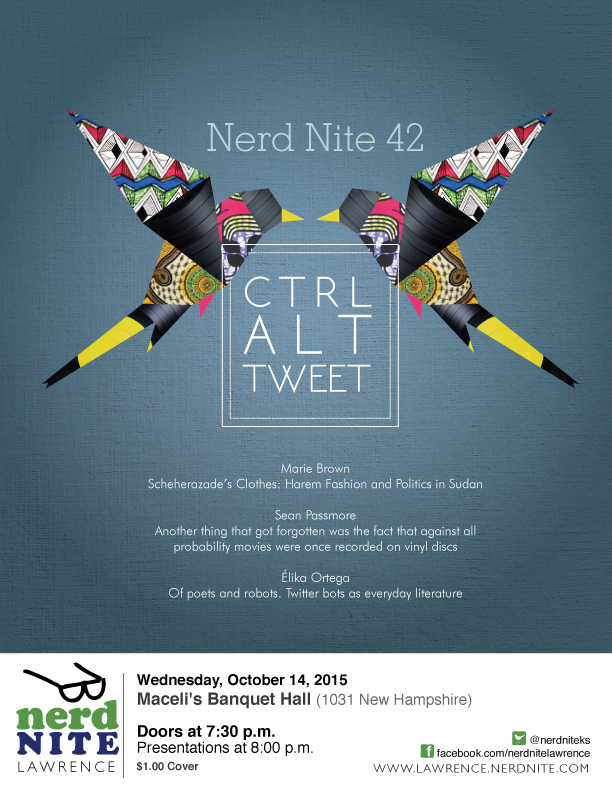
featuring:
Scheherazade’s Clothes: Harem Fashion and Politics in Sudan by Marie Brown
A strict culture of seclusion and limited access to formal education have long given scholars the impression that for much of the twentieth century Sudanese women were politically uninformed and isolated in their homes. But what if we’ve been looking for women’s voices in the wrong places? Why are historians so obsessed with (male-dominated) written documents? When we abandon texts for textiles, we find Sudanese women to be eager storytellers: weaving together tales of local celebrities, global revolution, Broadway plays, and space exploration in their clothes.
Marie Brown is an Assistant Professor of Middle East History at KU. Her book, Khartoum at Night: The Politics and Pleasures of Fashion in Imperial Sudan, argues that northern Sudanese women’s experiences of imperialism were expressed on and through their bodies. Her work on fashion means that she has a reputation to uphold and must always appear smartly dressed at work, parties, the farmers’ market, and even on errands to Cottin’s Hardware. When not buried under books, archival notes, or old photographs, Marie can be found knitting…or kickboxing.
“Another thing that got forgotten was the fact that against all probability movies were once recorded on vinyl discs” by Sean Passmore
The CED movie format from the 1980s was movies recorded on large vinyl discs. This format lost badly to other, better and more popular formats such as VHS & Laserdiscs.
Sean Passmore claims Lawrence as his hometown, despite growing up on a farm in Western Kansas and living in New York City throughout most of the ’00s. Sean was formerly a late night radio personality, under a pseudonym, at 105.9 the Lazer throughout the mid ‘90s, and is currently a car salesperson, collector of obscure information, Downtown Lawrence enthusiast and is good at jokes sometimes.
Of poets and robots. Twitter bots as everyday literature. By Élika Ortega
Twitter, like other social media, have a reputation of being the dark, superfluous doom of culture. Though crucial activist uses of Twitter have been common in social movements like the various versions of Occupy around the world, the microblogging platform still has to be seen as a place where arts ocurr. In this talk, I will talk about of Twitter bots in order to propose them as a radically contemporary literary phenomena that floods our everyday use of the platform.
Don’t know what a Twitter bot is? This talk is for you!
élika ortega
Élika is a Postdoctoral Researcher at the Institute for Digital Research in the Humanities at the University of Kansas. Before coming to Lawrence, she spent almost a decade in Canada, and before that, she grew up in Mexico City. She is nerdy about literature, computers, and weird books, both old and new.
A self-declared dog person, when she’s not working in the mysterious and wondrous field of Digital Humanities (don’t forget to ask her what that is) she likes to bind books, ride bikes, and run. You can find her on Twitter as @elikaortega
Wednesday, Sept. 16
Maceli’s (1031 New Hampshire)
Doors at 7:30, presentations at 8:00
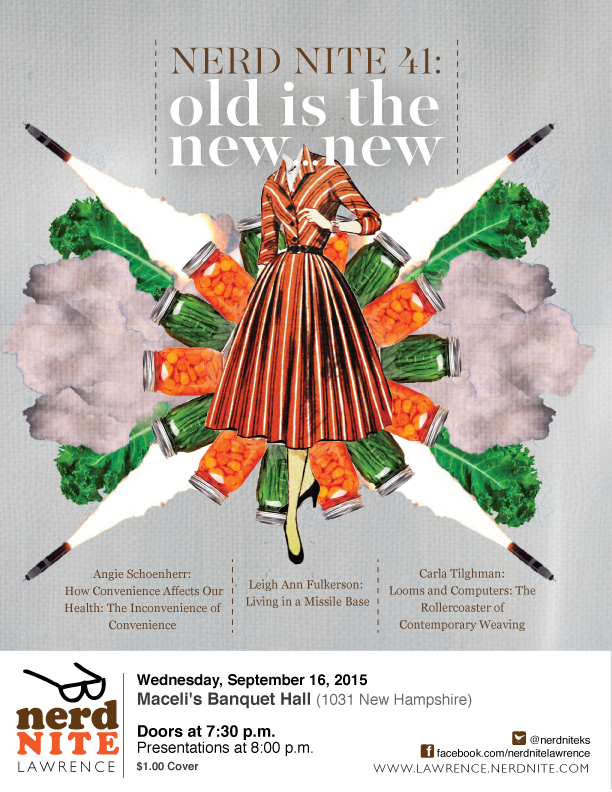
featuring:
How Convenience Affects Our Health: The Inconvenience of Convenience by Angie Schoenherr
It is no secret that convenience is a large part of our culture, but when does our pursuit for convenience no longer become so convenient? In this presentation, we will examine several points on how the pursuit of convenience influences our current health choices, examples of how we can approach convenience in a balanced manner, along with tips on how to gain a deeper understanding of your own relationship to health and convenience.
Angie Schoenherr received her certification as a Holistic Master Nutrition Therapist at the Nutrition Therapy Institute in Denver, Colorado. She currently works out of Southwind Health Collective and teaches nutrition classes at the Community Mercantile. Angie’s primary interest and motivation in being a nutritionist is based out of dissatisfaction with modern medicine and a desire to help others feel empowered to make their own health decisions. Aside from being a nutritionist, she spends her time playing music, painting, making up new dance
moves, taking naps, going to potlucks, and being an organizer for Girls Rock! Lawrence.
Living in a Missile Base: The Amazing Transformation of Cold War Infrastructure by Leigh Anne Fulkerson
In the two decades following World War II, the US spent billions of taxpayer dollars on defense. To compete with Russia in the race for space and as a nuclear deterrent, US missile systems were continually developed and improved. In this presentation you’ll learn more about these hardened, underground structures and see how some amazing people have transformed them from stark, abandoned places that once housed weapons of mass destruction into safe, comfortable and interesting housing for people.
As “Missile Base Specialists” Leigh Ann and Matthew Fulkerson first met, got married, and lived at an Atlas E missile base called Subterra Castle, which is located about 20 miles west of Topeka. From 2010 until last month, they worked with “20th Century Castles, LLC” the leaders in location, acquisition, and sales of missile bases nationwide. In 2013, they formed their own company, Plan B Consulting, LLC and purchased an Atlas F missile base in central Kansas. They are currently in the process of re-purposing it.
Looms and Computers: The Rollercoaster of Contemporary Weaving by Carla Tilghman
A brief exploration of the overlapping worlds of craft and technology, art and craft, gender and labor. All in 20 minutes. Contemporary digitally assisted looms developed from technology used in China 2000 years ago. In the west, these looms played a key role in the Industrial Revolution and simultaneously, in the development of the Modernist Textile movement. Many contemporary weavers now use digitally assisted looms to create woven products — which all stand on the ground on the ground of the gendered history of labor and the artworld. Really, all in 20 minutes.
Carla learned to spin and weave when she was 12 and has been fascinated with textiles in general and weaving in particular ever since. After a career as a paramedic (you never know where life will lead you), she earned my MFA in Studio Arts from Kent State University and am working on a PhD in American Studies from KU. No surprise, she is writing about …. you guessed it, weavers who use digital technology and looms. In her copious spare time, she chases after her child, hangs with her husband, plays with the cats and watches “Chicken TV” in her backyard. Oh, and she weaves like mad, because weaving is amazing.
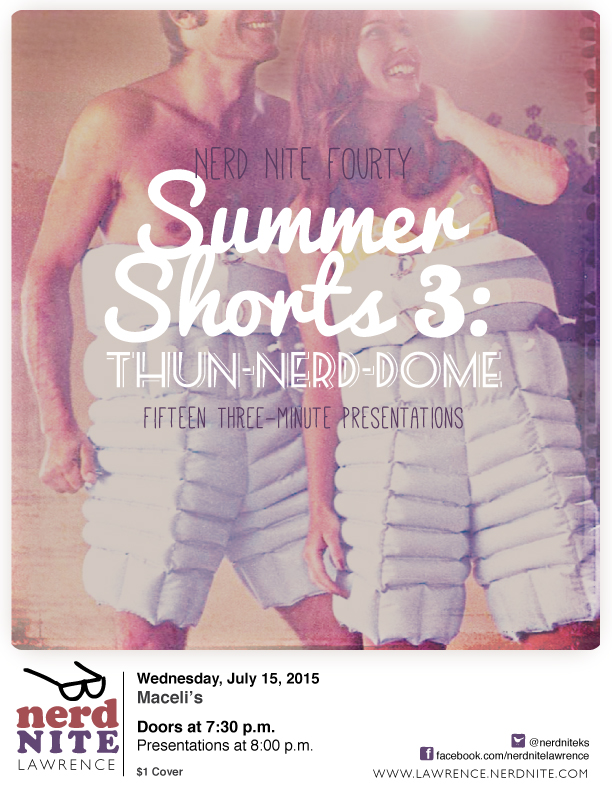
Summer Shorts is back on July 15th, Thun-Nerd-Dome style! Summer Shorts is our annual event where we flip Nerd Nite on its head. Instead of three 15 minute presentations, you will get to enjoy fifteen 3 minute presentations! Topics range from roller derby to pie crusts, wilderness to Ren Faires, and GPS to weightlifting! Doors open for our crazy event at Maceli’s at 7:30 pm with presentations starting at 8 pm. $1 cover for a night of fun!
Presenters include:
Allison Puderbaugh: “Wilderness or Why Mule Packing is Important”
Sally Chang: “The Many Lives of the Jellies”
Rustin Dodd: “The Winter of Ernest: Hemingway’s forgotten time just down the road”
Jenny O’Brien: “A Mating Call for Carpoolers”
Crystal Shepherd: “The Incredible Snatch Revealed”
Kate Meyer: “The Lattice Pie Crust: Fussy or Functional?”
Dawn Buehler: “Kansas Tributaries: Water Maze”
Kim Bellemere: “The Tallgrass Prairie: More Than Just Grass?”
Mark Reaney: “All Things Sherlock”
Emily Fekete: “Huzzah! There’s More to Ren Faires than Beer and Boobs”
Maulik Nariya: “Where the fork am I? Working principles of GPS”
Lindsey Givens: “Yellow Fever Pitch: the Ugly, the Bad, and the Good”
Jenica Nelson: “Stronger in numbers: Extraordinary Women Who Have Shaped America’s (and Kansas’) Environment”
Erin Schramm: “It Looks Cool but What the Hell is Happening? The Rules of Roller Derby”
Chris Ford: “Taking in the Good”
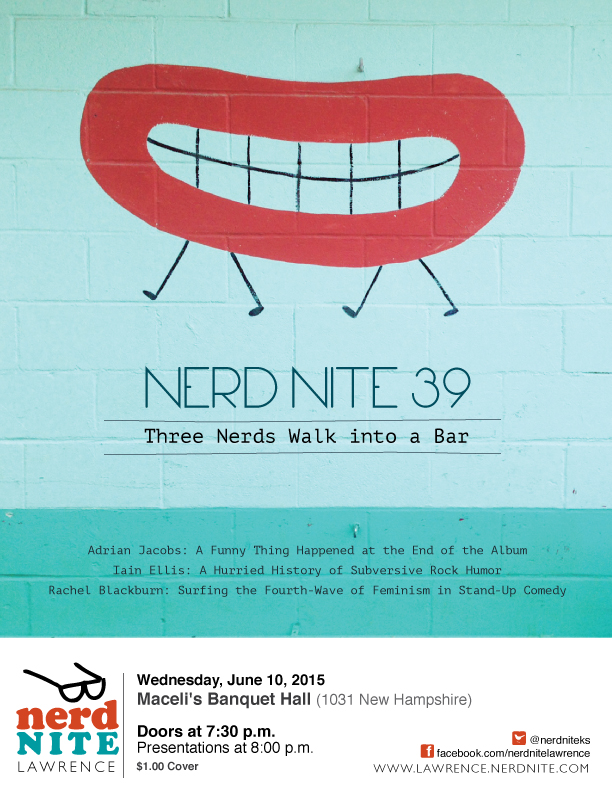
For our 40th Nerd Nite, we are going to explore the themes of music and comedy! In Nerd Nite 39: Three Nerds Walk into a Bar…, there will be presentations on hidden tracks, rock humor, and feminist stand-up. Join us on Wednesday, June 10th at Maceli’s at 8 pm. (Doors open at 7:30) $1 cover.
Adrian Jacobs: “A Funny Thing Happened at the End of the Album”
Exploring the stories, methods and madness behind some of the greatest hidden tracks of all time.
Adrian Jacobs is the Senior Communications and Operations specialist at LJWorld, Lawrence.com and KUsports.com and helps run the annual Best of Lawrence event. He’s on the board of the Social Media Club of Lawrence and is an alumni DJ with KJHK. A self-proclaimed musicologist, film buff, art history enthusiast, amateur videographer and recent High School Talent Show Judge, Adrian is also known to play guitar and “sing”
Iain Ellis: “A Hurried History of Subversive Rock Humor”
This presentation will throw a spotlight on the history of humor in rock music and its use as a weapon of anti-establishment rebellion. The performers who are the subjects are not merely musicians or comedians–they are artists whose works exude defiance and resistance, whether aimed at social structures, cultural mores, political systems, or the music industry itself. Subversive rock humorists serve as the conscience of our culture. They criticize pretensions, satirize hypocrisy, and pour scorn on power, corruption, and lies.
Born in Manchester and raised east of London, Iain Ellis now lives in LFK where he teaches classes on youth rebellion for the KU English Department. He mostly writes about humor and youth culture, writing over 50 articles for the online journalPopMatters and publishing 2 books on rock humor, Rebels Wit Attitude: Subversive Rock Humorists and Brit Wits: A History of British Rock Humor. When not writing or propping up the bar at the Replay, Iain performs and records with 3 local bands: KT/DG, The Leotards, and Heebie Jeebies.
Rachel Blackburn: “Surfing the Fourth-Wave of Feminism in Stand-Up Comedy”
Feminism has been lurking around comic corners for a long time, ever since Jane Austen penned her wit to paper and even before. So how then does our current wave of feminism play out on the stand-up comedy stage? Is feminist stand-up comedy just jokes made by women? For women? Involving vaginas and the wage gap? Or is there more to it? Take a look at the various layers of how fourth-wave feminist politics and social views are constructed through the new and exciting work of stand-up comics who self-identify all throughout that beautiful gender spectrum. We’ll look at the work of Free State Fest performer Tig Notaro, plus Hari Kondabolu and Adrienne Truscott among others, and the exchange between comedy and the fight for equality. Plus, you’ll learn the answer to the age-old question, “Can you write a feminist dick joke?”
Rachel Blackburn, M.F.A. (Virginia Commonwealth University) is currently a third-year Ph.D. student and instructor in KU’s Theatre Department. Her research explores the intersections of stand-up comedy, race, gender, transnational and performance studies. Her professional practice frequently involves directing and performing theatre, both abroad and domestically. This summer, she is teaching Public Speaking as Performance, directing a play reading, presenting her writing at a theatre conference to friendly Canadians, and performing in a New Play Development workshop in Montreal. When Rachel’s not imparting wisdom to her students or gleaning it from professors, she can be found playing her guitar, dancing to some sick beats (preferably by T-Pain), travelling the world, wishing she had a puppy, and laughing a lot with her friends along the way.
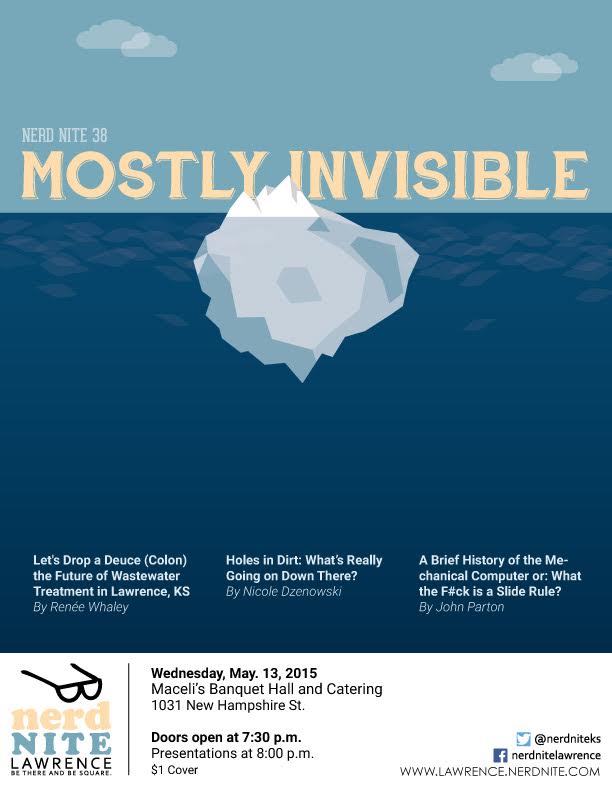
This month we’re exploring below the surface! Go underground with us to hear about fossilized animal burrows and how wastewater in Lawrence is treated and reclaimed. Then we’ll take a look inside your smartphone and be amazed that computers were once made of rocks.
Doors open at 7:30 at Maceli’s and presentations begin at 8. Cover is $1. Food served until 9-ish!
Presenters include:
Renée Whaley: “Let’s Drop a Deuce (Colon) the Future of Wastewater Treatment in Lawrence, Kansas”
Do you ever wonder what happens to water once it goes down the drain? Where do all the offerings to the porcelain princess go? What’s up with all this talk about the city building a second wastewater treatment plant? Wastewater treatment is the totally non-sexy, oft-forgotten sibling to water treatment, but as a community we’re poised to invest $70 million into building a new wastewater treatment plant and currently “sewer” adds the most to your utility bill. This presentation will (hopefully) demystify wastewater treatment, explain why the new plant will be super awesome, and inform you as to why your drains are not magical holes that lead to nothingness.
Renée is a graduate of the University of Kansas where she studied philosophy, and she currently works for the City of Lawrence Utilities Department which goes to show that there is life for humanities majors after school. She is a state certified water and wastewater operator, and in her free time she spoons with her cat, looks at stuff under a microscope and blogs about it (lfkulture.tumblr.com), and lifts like a bro, bro.
Nicole Dzenowski: “Holes in Dirt: What’s Really Going on Down There?”
It’s easy to think that nothing but worms and bugs make their living underground but the ground is practically alive under our feet with all sorts of animals, large and small. This presentation will introduce you to the many unexpected animals that burrow, modern and extinct, and how these burrows can be used by paleontologists to interpret ancient environments and ecosystems.
Nicole is a paleontology Ph.D. student in the geology department at KU. She is interested in all aspects of burrowing in extinct and modern vertebrates. While she thinks all vertebrates are cool, she knows that amphibians are the coolest. Deep down, you know this too. In the few sweet moments she gets outside of school she enjoys sleeping, watching the X-files, listening to Dave Matthews Band, and drinking fancy cocktails.
John Parton: “A Brief History of the Mechanical Computer or: What the F#ck is a Slide Rule?”
The presentation will cover the overall evolution of computational technology from counting pebbles to more sophisticated tools. The modern electronic computer is not a singular invention, but rather a long series of innovations, each improving on the previous work. This talk will give a glimpse at the sometimes obscured foundation of the devices that we use every day.
John is a computer programmer working here in Lawrence. He loves making his brain work on just about any topic he can get his hands on, but his real passions are mathematics and computer science.
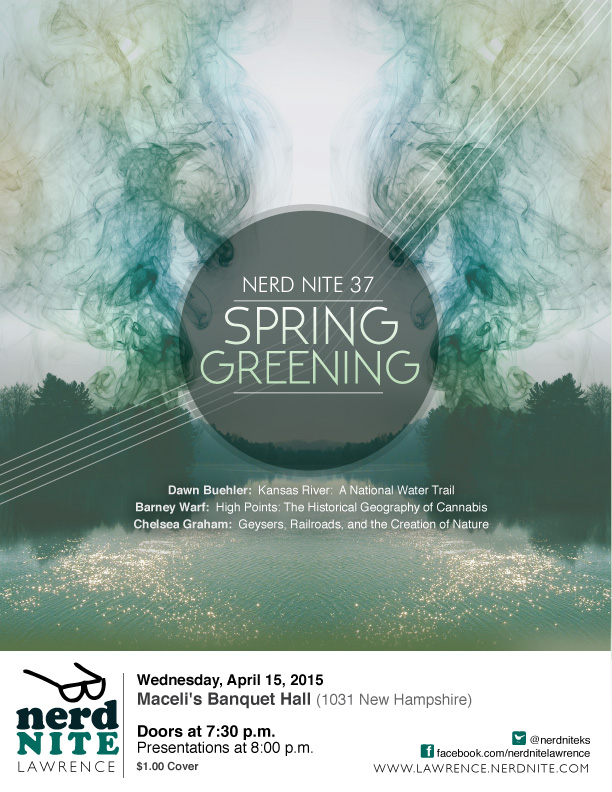
Spring has sprung in LFK! Join us this month as we celebrate nature with Nerd Nite 37: Spring Greening! There will be presentations on cannabis, the creation of Yellowstone National Park, and a talk from the Kansas River Keeper. Doors will open at Maceli’s at 7:30 pm on Wednesday, April 15. Snacks and full bar available! $1 cover.
Presentations will include:
Barney Warf: “High Points: The Historical Geography of Cannabis”
This presentation offers an overview of the diffusion of cannabis among different cultures, ranging from prehistoric Asia to the colonial world system to the contemporary United States. It examines the various ways in which cannabis has been tied up with local cultures and global politics, noting that until very recently it was legal and often promoted by governments around the world.
Barney is a professor of geography at the University of Kansas. His research covers a broad array of economic, social and political topics, particularly telecommunications and the internet. His hobbies, if anyone cares, include martinis, travel, jazz, wine, and science fiction.
Dawn Buehler: “Kansas River: A National Water Trail”
This presentation will discuss the Kansas River as a National Water Trail and give you an overview of the Kansas Riverkeeper’s role to protect and preserve the Kansas River. We will take a look at the history of the river, the watershed, advocacy for the rehabilitation of the Kansas River environs including water quality and wildlife habitat, and the promotion of compatible public recreational uses of the Kansas River.
Dawn is the Kansas Riverkeeper , a non-governmental public advocate for the Kansas River who holds the community accountable for the health of the river. As a member of the Waterkeeper Alliance, she is supported by Friends of the Kaw, a grassroots conservation group dedicated to protecting the Kansas River.
Chelsea Graham: “Geysers, Railroads, and the Creation of Nature”
Of all the flora and fauna protected in Yellowstone National Park, the most ubiquitous is steam. Steam in Yellowstone is evidence of the hundreds of hydrothermal features for which the park is most renowned and that in 1872 served as the primary justification for the park’s establishment. Since, hundreds of thousands of people flock every year from all over the world to visit the natural “Wonderland” found at Yellowstone. However, steam played a much more foundational role in the establishment of Yellowstone National Park by way of the steam engines of the Northern Pacific Railroad. This presentation explores the curious history of steam in relationship to Yellowstone National Park and questions the ways in which we articulate the purity and power of natural places.
Chelsea is a PhD Candidate specializing in Rhetoric at the University of Kansas where she is writing a dissertation about the relationship between rhetorics of steam and the effects of Industrial Modernity. When she’s not busy answering the question “what is rhetoric?,” she enjoys the outdoors, cooking, sports, and fantasizing about life after graduate school. She’s inclined to believe it’s probably not bad.
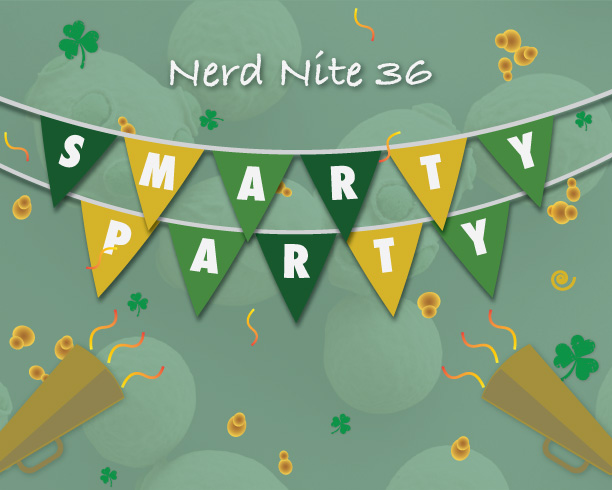
It is our first Nerd Nite at our new location! Join us at Maceli’s for Nerd Nite 36: Smarty Party! Our party themed event will feature presentations on noise induced hearing loss, St. Patrick’s Day, and craft beer from Free State’s head brewer! There will also be a SNACKS menu with items such as french fries, hummus and pita, vegetarian antipasto sliders, and BBQ pork sliders. Plus a full bar and MORE SPACE! That’s right, we no longer have to turn anyone away!
Join us on March 11th when doors open at 7:30 pm. Presentations will start at 8:00 pm. Still only $1 cover! Maceli’s is located at 1031 New Hampshire St.
Presentations include:
Aryn Kamerer: “Come on Feel the Noise: Noise-Induced Hearing Loss and You.”
Everyone knows that noise is bad for your ears, but just how much noise is too much noise? If you have ever asked yourself what exactly is going on behind your ear drum when you’re at Allen Fieldhouse or a St. Paddy’s Day party, look no further! Aryn will take you on a thrilling journey through the ear and discuss new research in noise-induced hearing loss that challenges the field’s previous ideas on why so many of us need hearing aids when we age.
Aryn received her BA in Speech-Language Pathology at KU and is currently pursuing a PhD in Audiology at the University of Kansas Medical Center. She spends most of her time in the Auditory Physiology Lab where her research focuses on creating new diagnostic techniques for identifying hearing loss, and the Electrical Hearing Lab where she is working on quantifying cognitive listening effort in people with cochlear implants. Although Aryn loves to preach about hearing protection, you can find her many a night in front of the stage at the Bottleneck, Jazzhaus, or Green Lady in KC.
Stephen Hassard: “St. Patrick’s Day: Time to fly the red, white, and blue.”
St. Patrick’s is a day of drinking green beer and shamrock shakes. But how much of St. Patrick’s day celebrations accurately reflects what we know about St Patrick? Considering the British and American influences on making St. Patrick’s day what it is today shouldn’t we be flying the red white and blue instead of the green, white and orange? The issue though is that in Ireland what flag you fly is ladened with religious and political connotations. In this talk we’ll discuss some of the different flags associated with St. Patrick and what those mean to different demographics of the Irish Population.
Stephen is an Irish-man who grew up in the colds of Canada (he says ‘eh’ far more often than ‘wee’ – unless there is beer involved or if the Irish consulate is jerking him around). When he isn’t eating potatoes Stephen works at Garmin as a UX Designer.
Geoff Deman: “Bud scars, Mutants, and Cannibals: the Wonderful, Horrible Life of Saccharomyces Cerevisiae.”
Geoff forsook his degree in Art History some 20 years ago and embarked upon an beer-fueled bender in fermentation sciences, in Seattle during its Craft Beer nascency. Geoff’s ongoing odyssey in brewing landed him at the Free State back in 2002 where his continuing education in beer has included multiple stints judging at the Great American Beer Festival and World Beer Cup, scholarship with the Master Brewers Association of America, travels far and wide, and authoring the briefest of entries in the Oxford Companion to Beer. All that is well and good, but he finds ultimate satisfaction with a mash paddle in hand, tending to a brew and looking out to see smiling faces enjoying the beer he brews.
Information about our new venue, Maceli’s, here: http://www.macelis.com/
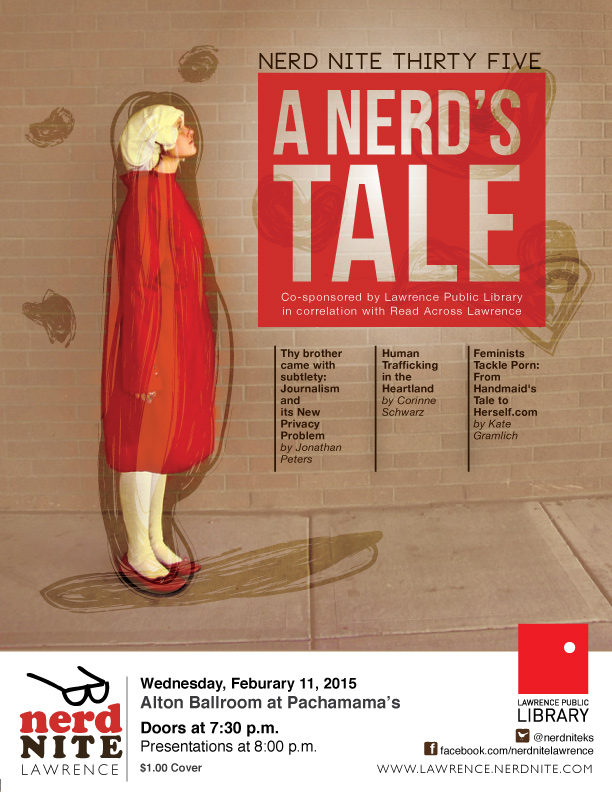
It’s our last Nerd Nite at Pachamama’s Alton Ballroom 🙁 On February 11, come celebrate Pachamama’s and Read Across Lawrence with presentations related to Margaret Atwood’s dystopian novel The Handmaid’s Tale. Presentations will cover topics from Feminist interpretations of porn, to human trafficking, to privacy in a digital age. Doors will open for the event at 7:30 and presentations will start at 8:00. $1 cover.
Jon Peters: “Thy brother came with subtlety: Journalism and its New Privacy Problem”
In the digital world, almost everything you do leaves a trace. That’s a problem for journalists who need to protect confidential sources and information. This talk will explore how journalists are navigating a new set of privacy challenges.
Jonathan Peters, an attorney, is an assistant professor of journalism at the University of Kansas, where he teaches media law. He is also a faculty affiliate at the KU Information and Telecommunication Technology Center.
Kate Gramlich: “Feminists Tackle Porn: From Handmaid’s Tale to Herself.com”
Radical feminists and staunch conservatives almost never see eye to eye… except when it comes to porn. In Margaret Atwood’s The Handmaid’s Tale, both the pre-Gileadean feminists and the controlling religious regime stood firmly against pornography’s harmful imagery. However, the issue is even further complicated in American society today by debates within feminism on whether porn is inherently oppressive or able to be a site for empowerment.
My goal of this talk is to give a brief overview of the conflicting narratives within feminist theory, introducing key players and arguments of both “anti-pornography” and “anti-censorship”/”pro-sex” feminisms. I will draw in quotes from The Handmaid’s Tale, this year’s Read Across Lawrence book, as well as incorporating more recent discussions on the topic. It is my hope for audience members to use this information as a framework for discussing porn and feminism, as Right vs. Wrong, but more as an open-ended conversation about a complex issue.
Kate is a member of the (fantastic) Readers’ Services staff at the Lawrence Public Library and a recent Kansas transplant. She studied communication and taught women’s studies at Southern IL University Carbondale and is now thrilled to be a part of the Lawrence community. Find her in the fiction loop at the library to chat about books, feminism, cats, glitter, etc.
Corinne Schwarz: “Human Trafficking in the Heartland”
Human trafficking is a phenomenon we don’t usually encounter outside of breaking news updates and “Law and Order: SVU” marathons. But the hidden population of vulnerable, exploited, and trafficked persons does exist in our Kansas communities. Additionally, some interesting Kansas politicians have been major players in state and national-level anti-trafficking policy. This talk will establish the climate of human trafficking and anti-trafficking advocacy across the state and show how trafficking exists outside of our sensationalized media narratives.
Corinne is a graduate student in the Women, Gender, and Sexuality Studies Department at KU. She is also a graduate research assistant with KU’s Anti-Slavery and Human Trafficking Initiative (ASHTI), an interdisciplinary working group examining vulnerability, exploitation, and trafficking. Her own research looks at anti-human trafficking interventions and health services delivery in rural and underserved communities. When she’s not researching, she’s probably eating a burrito.
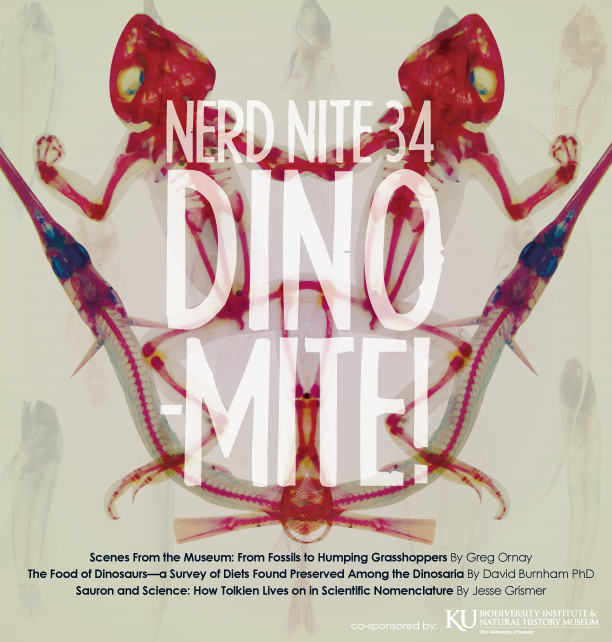
We’re Back! And this month Nerd Nite is teaming up with the KU Biodiversity Institute and Natural History museum to bring you three nerdy presentations exploring the museum, dino diets, and the Tolkien inspired naming of new species. We will still be at Pachamama’s Alton Ballroom for the next couple months so you can get your fill of Pachamama’s before they close after Valentine’s Day 🙁
Join us: January 14th. Doors at 7:30, presentations at 8:00 pm! $1 cover. Come early to experience our activity table where you can make your own fossil print!
Presentations include:
Greg Ornay “Scenes from the Museum: From Fossils to Humping Grasshoppers”
Working at KU Natural History Museum you get to see many unique things and get caught up in some crazy situations dealing with live animals (sometimes wild ones) and insects. There are over 10 million specimens and only a small percentage makes it into the public exhibits. Working as an exhibits specialist has allowed my to go behind the scenes and explore some of the most extensive and unique collections. I will take you on a journey behind the scenes of Bug Town, the bee colony, secrets of the panorama, creating exhibits that connect and resonate with people, and much more that have been in the making for years and still continuing.
Greg first started out, as an artist working is such mediums as Sculpture, performance and installation art. During his time in College he worked for several art galleries and a few museums. Always being on the creative side he wound up working for KU’s Natural History Museum. For the last 10 years he has been creating exhibits at the museum. From concept, design, fabrication, and installation he has used his art background to showcase new exhibits to the public.
Jesse Grismer “Sauron and Science: How Tolkien Lives on in Scientific Nomenclature”
Naming new species of plants and animals can be a great way to bridge passions eg. fantasy, comics, scifi, research, etc. When a new species is discovered we get to choose the species’ name. So we have named species after Gollum or from areas in the Tolkien Universe such as the Elves of Las Gallen. There is no reason not to infuse research with other areas of our lives that we are passionate and excited about. This also how shows that not all scientist are stuffy or dorky and makes our work more engaging to the general public. It gets them asking questions, like can you do that? Does it still count? Then this opens up a dialogue about how and why describing species is important and vital to conservation but can also be a blast man!!
David Burnham “The Food of Dinosaurs—a survey of diets found preserved among the Dinosauria”
My talk is about dinosaurs and what they ate. Not what we think they ate based on their teeth and claws, but rather on scientific evidence such as what was found inside their bellies. Such remains of the past are rare insights and bring interesting conclusions that I will share during my talk.
David read the stories that are embedded in the rocks. Rocks are time capsules and if you learn how to read them they become windows into the past. This allows one to time travel and see long extinct life forms from a very distant past. And that is what captivates David to this day. Soon he realized that looking was no longer enough. Not only did he want to look into the past, David also want to extract the primitive life forms that seemed to be locked in stone. You see, the name fossil means something “dug up” and he wanted to do just that. However, he wanted to not only go back in time, but he wanted to put fossil organisms back together and make them whole again. Then he would see the entire picture and discover the unknown. This has manifested itself as a life-long career as a time traveler. In more formal circles we are called Paleontologists. But we remain as inquisitive children looking at rocks and stones for clues no one else can see.
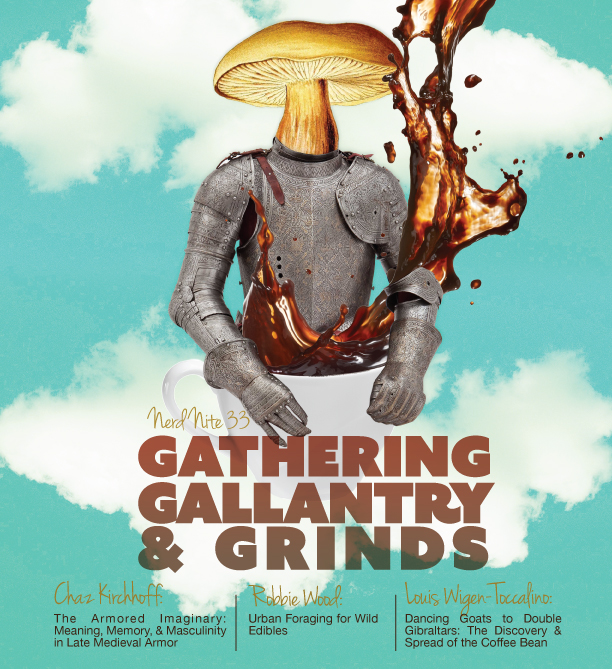
It’s our 3rd birthday! Come and celebrate with Nerd Nite 33: Gathering, Gallantry, and Grinds. Join us on November 12 at Pachamama’s Alton Ballroom as we explore the history of coffee, masculinity and medieval armor, and foraging for wild eats! Doors will open this month at 7:30 and presentations will start at 8:00. $1 cover. There will be cake!
Presentations include:
Louis Wigen-Toccalino: “Dancing Goats to Double Gibraltars: the discovery and spread of the coffee bean”
Louis learned how to cook from his grandmother, drinks 205 quarts of coffee a year, and views tea with disdain. He is a pedant, an optimist, a risotto master; he can often be found waxing philosophic at a local watering hole. He opened Decade in LFK to share the gospel of caffeine, with anyone who will listen.
Chaz Kirchhoff “The Armored Imaginary: Meaning, Memory, and Masculinity in Late Medieval Armor”
My talk will explore two facets of the complex relationship between armor, masculinity, and memory during the period between 1480 and 1530, when the forms, functions, and meanings of plate armor were undergoing significant changes in response to new military technology (like gunpowder) and shifting models of political power. First, I will discuss how specific armors (that is, sets of plates now commonly called “suits of armor”) were memorable surfaces upon which identities, events, and political contexts could be impressed, recalled, and reimagined, illustrated through art. Second, I will describe how armor, which was specially-crafted to fit its intended wearer, could become an impression of the body that functioned as a surrogate presence of the person it once encased. Thus, the two parts of my Nerd Nite talk will share how both real armors and images of the armored body could help to construct 15th- and 16th-century ideals of knightly masculinity and could become repositories of memory where such powerful ideals and identities were preserved and recalled.
Chaz has managed to combine her artistic background in steel and non-ferrous metalwork with her passion for art historical research in her exploration of the creation, use, and meaning of plate armor in late medieval and renaissance Europe, particularly in the German-speaking lands of the Holy Roman Empire. Chaz received undergraduate degrees in Art History and Sculpture from Drury University and an MA in Art History from KU, where she is currently pursuing a PhD. She worked as a curatorial intern at the Spencer Museum of Art for three years in the departments of European and American Art and Works on Paper, and it was there that she discovered her interest in armor while conserving a breastplate in the gothic style. Chaz is currently working on a dissertation entitled “Constructing the Armored Body in the Fifteenth- and Sixteenth-Century Holy Roman Empire,” and spent part of last summer analyzing armors, manuscripts, and related artworks in the Prague Museum of Decorative Art and the Kunsthistorisches Museum in Vienna.
Robbie Wood: “Urban Foraging for Wild Edibles”
Talking about some local wild foods. Specifically Persimmons as they are in season right now. But also two of the most common weeds in the world plantain and dandelions and how we can incorporate them into our lives instead of just mowing them over.
Robbie Wood is a Senoir at Haskell Indian Nations University. He is from a rural area in Northeastern Oklahoma. His granparents were old timers and knew a lot about farming and gathering wild foods, something he was fascinated by and decided to make a goal to learn.









